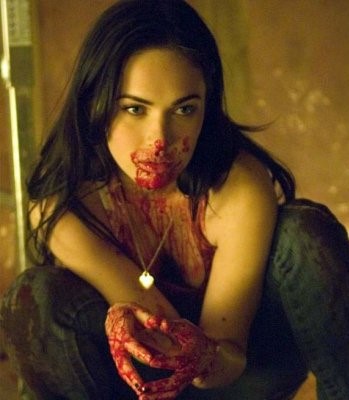
When I sat down with this issue’s cover artist, Michelle Perez, and asked what has been inspiring her recently, she brightened: “Girl monster movies.” Specifically, Jennifer’s Body.
After moving to Providence from Jacksonville, FL (which she describes as stripmall country) to study illustration at RISD, Perez started researching the local lore and learned of the dense and often macabre history of New England. Inspired by the gothic landmarks of her surroundings, as well as her love for horror and horror film analysis, she drew inspiration from her neighborhood on the East Side for her cover art, “Crossing Angells.”
Perez based the character design for the piece on costumes in Les Vampires, using red watercolor and charcoal to render a velvety, deep texture. The same red as the blood in Jennifer’s Body, the blood of the high school football captain Megan Fox disembowels. And the blood dripping down from her mouth, staining her Elizabethan prom dress. And the hearts on her velour zip-up hoodie.
When I asked Perez about the medium she used for this piece, she mentioned that she used to draw digitally but has since switched to using physical mediums to achieve more texture. She then layers digitally as needed. While we talked, she showed me the pieces separately, the bat figures that she later placed onto the background. I like the idea of these red bat figures being dropped into a world separate from them. Perez chose a night scene purposefully, noting, “Benefit Street feels old at night when you can’t really see the power lines. I feel like the historical part of it, the spooky part of it, is enhanced at night under the orange lamps and the deep shadows.”
The word “monster” is derived from the Latin “mostrare,” meaning to show, and “moner,” meaning to warn. In its earliest meanings, a monster was a bad omen, a demonstration of evils lying ahead. Good guys and bad guys – you know the story.
Modern horror tends to complicate the paradigm of good versus evil, exploring the mucky in between. I ask Perez if the bat figures are monsters. She confirmed the two facing the reader are humans in costumes – but that the third member looks slightly different, semi-translucent and backlit by the moonlight, showing veins underneath. We cannot see the third triomember’s face. Perhaps we can’t be so sure.
Over the summer, before the leaves started turning on Angell St, Perez read Carol Clover’s Men, Women, and Chainsaws, which argues that many early horror tropes of fear, terror, and violence were rooted in feminine experiences while the target audience was often young men. She is interested in how these tropes continue to persist as horror becomes more diverse.


One such contemporary is Carmen Maria Machado, whom Perez underscored as an inspiration, saying, “She has a way of describing those deeply personal emotions with horror tropes, and you can tell how much she loves the genre and can use it to depict these really emotional scenes and stories. I love her.” Machado loves Jennifer’s Body as well. She wrote an essay titled “Both Ways” about Jennifer’s Body and bisexuality, which was included in the queer horror anthology It Came From the Closet. She writes, “The film’s execs thought she [Megan Fox] would be a draw for teenage boys, but teenage boys hated it. They didn’t know they were coming to be eaten. Not like that.”
The genre of horror is changing as more people are brought into the fold, slowly but (hopefully) steadily. Perez notes the impactful storytelling of the horror she loves, the layers of identity and experience that provide context for what may otherwise be flatly deemed bad behavior. In this way, female monster movies like Jennifer’s Body can provide catharsis in a world where it is often scant. Perez says, when she watches a movie with a monstrous woman, “Good for her.”
